
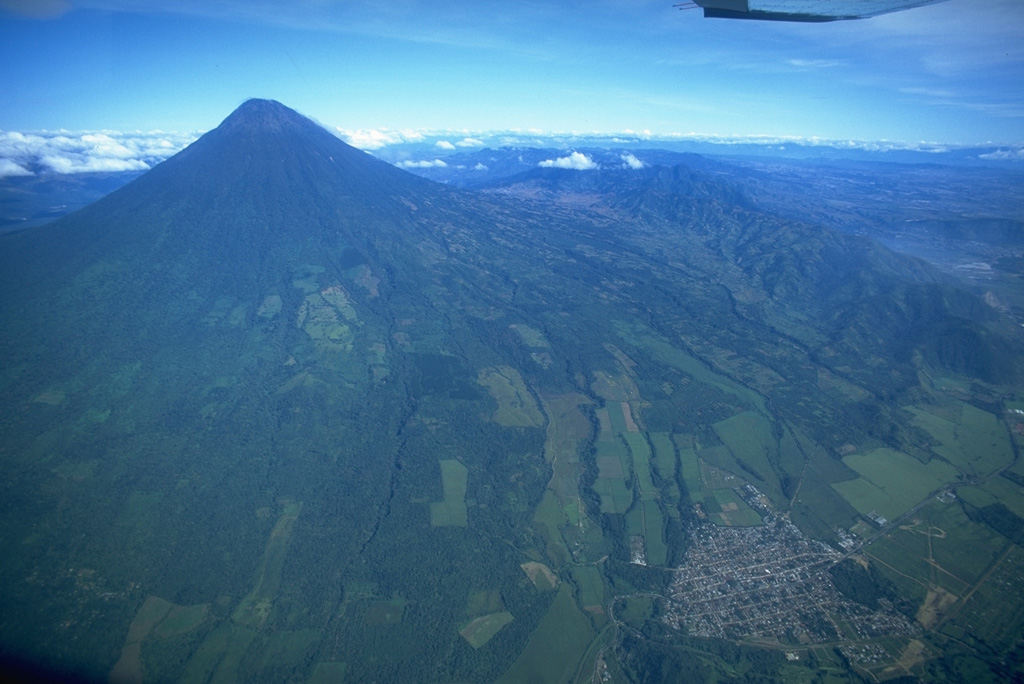
The Global Volcanism Program has no activity reports available for Agua.
The Global Volcanism Program has no Weekly Reports available for Agua.
The Global Volcanism Program has no Bulletin Reports available for Agua.
|
|
||||||||||||||||||||||||||||
There is data available for 0 confirmed eruptive period.
[ 1541 Sep 11 ] Discredited Eruption
This compilation of synonyms and subsidiary features may not be comprehensive. Features are organized into four major categories: Cones, Craters, Domes, and Thermal Features. Synonyms of features appear indented below the primary name. In some cases additional feature type, elevation, or location details are provided.
Synonyms |
||||
| Hunahpu | ||||
Cones |
||||
| Feature Name | Feature Type | Elevation | Latitude | Longitude |
| Jaboncillo, Cerro | Pyroclastic cone | 1520 m | 14° 25' 0.00" N | 90° 43' 0.00" W |
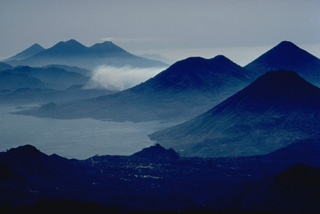 This dramatic photo looking SE down the axis of a chain of volcanoes extending across Guatemala shows six Quaternary volcanoes and one large caldera. Beginning in the right foreground are three volcanoes, San Pedro, the conical Atitlán, and Tolimán, that are constructed on the southern shore of Lake Atitlán, which fills a large Pleistocene caldera. The three volcanoes in the distance are, from left to right, Agua, Acatenango, and Fuego. Tolimán-Atitlán and Acatenango-Fuego are paired volcanoes along N-S lines.
This dramatic photo looking SE down the axis of a chain of volcanoes extending across Guatemala shows six Quaternary volcanoes and one large caldera. Beginning in the right foreground are three volcanoes, San Pedro, the conical Atitlán, and Tolimán, that are constructed on the southern shore of Lake Atitlán, which fills a large Pleistocene caldera. The three volcanoes in the distance are, from left to right, Agua, Acatenango, and Fuego. Tolimán-Atitlán and Acatenango-Fuego are paired volcanoes along N-S lines.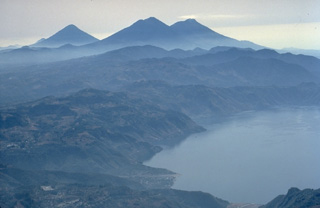 The twin volcanoes of Acatenango (left) and Fuego rise in the center beyond Lake Atitlán, with the conical peak of Agua volcano to their left. Lake Atitlán fills the latest of three large calderas produced during the Pleistocene at Atitlán. A steam plume originates from the summit of Fuego, one of Guatemala's most active volcanoes.
The twin volcanoes of Acatenango (left) and Fuego rise in the center beyond Lake Atitlán, with the conical peak of Agua volcano to their left. Lake Atitlán fills the latest of three large calderas produced during the Pleistocene at Atitlán. A steam plume originates from the summit of Fuego, one of Guatemala's most active volcanoes. 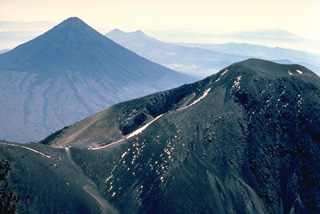 This photo looking SE across the volcanic chain of Guatemala shows Fuego volcano, lightly dusted with snow, in the foreground, and the symmetrical Agua volcano at the upper left. Twin-peaked Pacaya volcano is located behind the right flank of Agua, and the broad massif in the distance above the summit of Fuego is Tecuamburro volcano. Fuego and Pacaya are two of Guatemala's most active volcanoes.
This photo looking SE across the volcanic chain of Guatemala shows Fuego volcano, lightly dusted with snow, in the foreground, and the symmetrical Agua volcano at the upper left. Twin-peaked Pacaya volcano is located behind the right flank of Agua, and the broad massif in the distance above the summit of Fuego is Tecuamburro volcano. Fuego and Pacaya are two of Guatemala's most active volcanoes.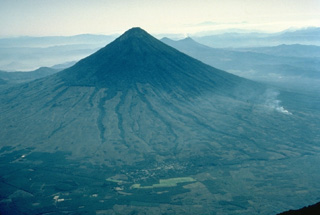 The symmetrical, forested Volcán de Agua stratovolcano forms a prominent backdrop to both the historic former capital city of Antigua Guatemala and Guatemala City, the present capital. The 3760-m-high Agua volcano has a small, circular crater that is breached on the NNE side. Agua has had no historical eruptions, but a devastating mudflow on September 11, 1541, destroyed the first Guatemalan capital city, now known as Ciudad Vieja. This view from the NW also shows the twin-peaked Pacaya volcano behind the upper right flank of Agua.
The symmetrical, forested Volcán de Agua stratovolcano forms a prominent backdrop to both the historic former capital city of Antigua Guatemala and Guatemala City, the present capital. The 3760-m-high Agua volcano has a small, circular crater that is breached on the NNE side. Agua has had no historical eruptions, but a devastating mudflow on September 11, 1541, destroyed the first Guatemalan capital city, now known as Ciudad Vieja. This view from the NW also shows the twin-peaked Pacaya volcano behind the upper right flank of Agua.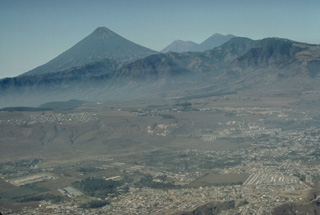 The beautifully symmetrical Agua volcano forms a prominent backdrop to Guatemala City in the foreground. The twin volcanoes of Fuego (left) and Acatenango (right) appear to the right of Agua in this 1983 view from the NE. No historical eruptions are known of Agua volcano, despite its youthful profile.
The beautifully symmetrical Agua volcano forms a prominent backdrop to Guatemala City in the foreground. The twin volcanoes of Fuego (left) and Acatenango (right) appear to the right of Agua in this 1983 view from the NE. No historical eruptions are known of Agua volcano, despite its youthful profile.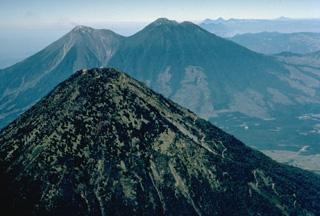 The forested summit of symmetrical Agua volcano appears in the foreground with the twin volcanoes of Fuego (left) and Acatenango (right) in the background. The three stratovolcanoes overlook the historical city of Antigua Guatemala, whose outskirts appear on the right. Agua has had no historical eruptions, in contrast to Acatenango and especially Fuego, which is one of the most active volcanoes of Guatemala. This 1983 aerial view is from the west.
The forested summit of symmetrical Agua volcano appears in the foreground with the twin volcanoes of Fuego (left) and Acatenango (right) in the background. The three stratovolcanoes overlook the historical city of Antigua Guatemala, whose outskirts appear on the right. Agua has had no historical eruptions, in contrast to Acatenango and especially Fuego, which is one of the most active volcanoes of Guatemala. This 1983 aerial view is from the west.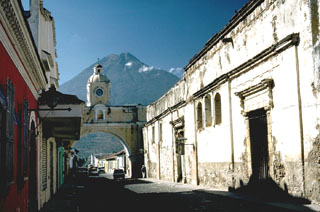 Volcán de Agua behind the historical colonial city of Antigua Guatemala and is one of three large volcanoes surrounding the town. The capital city of Guatemala was moved here following a catastrophic mudflow from Agua in 1541 that destroyed the former capital city, now known as Ciudad Vieja.
Volcán de Agua behind the historical colonial city of Antigua Guatemala and is one of three large volcanoes surrounding the town. The capital city of Guatemala was moved here following a catastrophic mudflow from Agua in 1541 that destroyed the former capital city, now known as Ciudad Vieja.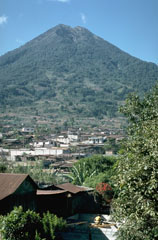 Volcán de Agua towers above the town of Santa María de Jesús on its NE flank. A scarp on the upper north flank extending from the summit crater was the source of a major debris flow in 1541 that destroyed towns on the NW flank. This catastrophe was not accompanied by an eruption.
Volcán de Agua towers above the town of Santa María de Jesús on its NE flank. A scarp on the upper north flank extending from the summit crater was the source of a major debris flow in 1541 that destroyed towns on the NW flank. This catastrophe was not accompanied by an eruption.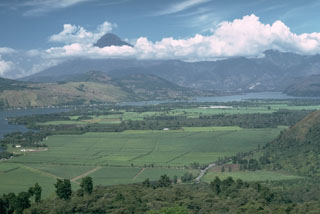 Volcán de Agua (left) rises above the clouds west of Lake Amatitlán, located within the Amatitlán caldera. This 14 x 16 km Pleistocene caldera has produced many large explosive eruptions whose deposits underlie Guatemala City and surrounding areas. Pacaya volcano, out of view to the left, was constructed over the buried southern rim of Amatitlán caldera.
Volcán de Agua (left) rises above the clouds west of Lake Amatitlán, located within the Amatitlán caldera. This 14 x 16 km Pleistocene caldera has produced many large explosive eruptions whose deposits underlie Guatemala City and surrounding areas. Pacaya volcano, out of view to the left, was constructed over the buried southern rim of Amatitlán caldera. 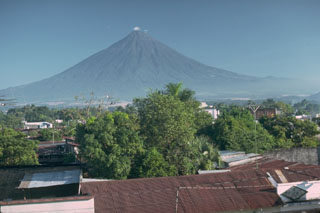 Volcán de Agua rises above the city of Escuintla, which underlies a massive debris avalanche deposit from the Fuego-Acatenango massif, out of view to the left.
Volcán de Agua rises above the city of Escuintla, which underlies a massive debris avalanche deposit from the Fuego-Acatenango massif, out of view to the left. 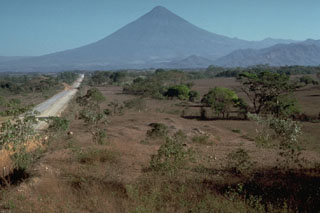 Volcán de Agua towers above the Pacific coastal plain to its south. The foreground surface is part of the massive Escuintla debris avalanche deposit most likely produced by collapse of the Acatenango-Fuego massif out of view to the left.
Volcán de Agua towers above the Pacific coastal plain to its south. The foreground surface is part of the massive Escuintla debris avalanche deposit most likely produced by collapse of the Acatenango-Fuego massif out of view to the left.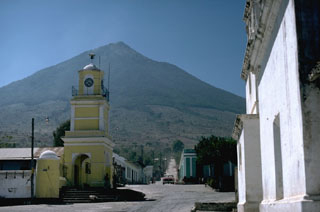 Volcán de Agua seen to the east above the ancient capital city of Ciudad Vieja. A lahar from Agua in 1541 CE destroyed this city, the first capital established by the Spanish. The catastrophe caused the capital city to be relocated to nearby Antigua Guatemala.
Volcán de Agua seen to the east above the ancient capital city of Ciudad Vieja. A lahar from Agua in 1541 CE destroyed this city, the first capital established by the Spanish. The catastrophe caused the capital city to be relocated to nearby Antigua Guatemala.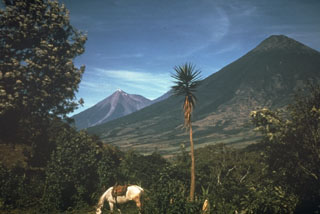 Volcán de Agua, seen here from the NE, is the most prominent volcano visible from Guatemala City. Fuego volcano in the background has been much more active historically.
Volcán de Agua, seen here from the NE, is the most prominent volcano visible from Guatemala City. Fuego volcano in the background has been much more active historically. 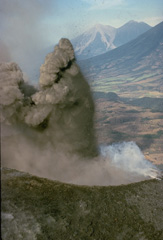 An explosion from MacKenney crater on Pacaya volcano ejects a dark, ash-rich column and individual blocks that are sometimes incandescent even during daylight hours. This December 1974 photo shows Fuego (left) and Acatenango (right) volcanoes in the background, behind the sloping flanks of Agua volcano.
An explosion from MacKenney crater on Pacaya volcano ejects a dark, ash-rich column and individual blocks that are sometimes incandescent even during daylight hours. This December 1974 photo shows Fuego (left) and Acatenango (right) volcanoes in the background, behind the sloping flanks of Agua volcano. Volcán de Agua is seen here in an aerial view from the SE, with the town of Palín to the lower right along the highway between Guatemala City (just out of view to the right) and Escuintla.
Volcán de Agua is seen here in an aerial view from the SE, with the town of Palín to the lower right along the highway between Guatemala City (just out of view to the right) and Escuintla. 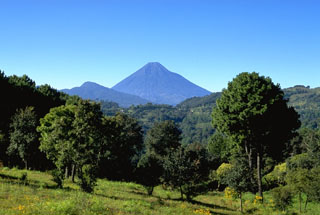 Volcán de Agua is one of Guatemala's prominent stratovolcanoes. Seen here from the north, the breached summit crater is visible.
Volcán de Agua is one of Guatemala's prominent stratovolcanoes. Seen here from the north, the breached summit crater is visible.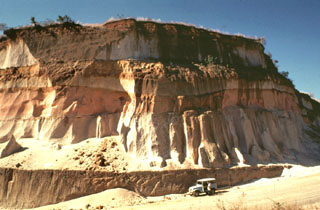 Thick units of the 84,000-year-old Los Chocoyos Ash are exposed south of Guatemala City, more than 100 km from its source at Atitlán caldera. Three units are visible here. The pinkish unit across the center of is the oxidized top of the pyroclastic flow deposit. The bottom two white units are the top and bottom halves of the deposit. The two fall deposits above the Los Chocoyos Ash are unit E from Amatitlán caldera and the younger unit C from Volcán de Agua.
Thick units of the 84,000-year-old Los Chocoyos Ash are exposed south of Guatemala City, more than 100 km from its source at Atitlán caldera. Three units are visible here. The pinkish unit across the center of is the oxidized top of the pyroclastic flow deposit. The bottom two white units are the top and bottom halves of the deposit. The two fall deposits above the Los Chocoyos Ash are unit E from Amatitlán caldera and the younger unit C from Volcán de Agua.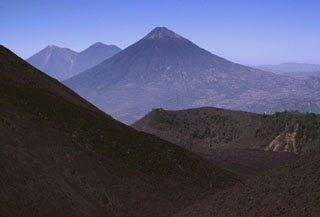 Volcán de Agua is in the center of this photo and lava flows from MacKenney cone form the slope in the foreground. They have filled in the moat of the Pacaya caldera almost to the level of the lower Cerro Chino crater rim, with the communication antennas along the summit in the midground. The two volcanoes on the left horizon are Fuego (left), one of the most active in Guatemala, and Acatenango (right).
Volcán de Agua is in the center of this photo and lava flows from MacKenney cone form the slope in the foreground. They have filled in the moat of the Pacaya caldera almost to the level of the lower Cerro Chino crater rim, with the communication antennas along the summit in the midground. The two volcanoes on the left horizon are Fuego (left), one of the most active in Guatemala, and Acatenango (right).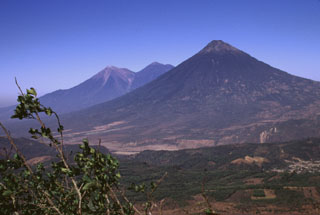 This view from Pacaya shows Fuego and Acatenango (left) and conical Volcán de Agua volcano (right). These impressive volcanoes all exceed 3.5 km in elevation and rise from near sea level on the Pacific coastal plain to the south. Volcanism at the Acatenango-Fuego pair has migrated southwards, and Fuego, its summit kept free of vegetation by frequent eruptions, is one of Guatemala's most active volcanoes.
This view from Pacaya shows Fuego and Acatenango (left) and conical Volcán de Agua volcano (right). These impressive volcanoes all exceed 3.5 km in elevation and rise from near sea level on the Pacific coastal plain to the south. Volcanism at the Acatenango-Fuego pair has migrated southwards, and Fuego, its summit kept free of vegetation by frequent eruptions, is one of Guatemala's most active volcanoes.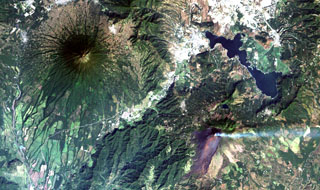 Steaming Pacaya volcano (lower right) lies across a valley from symmetrical Agua volcano (upper left). Pacaya was constructed near the southern margin of Amatitlán caldera, whose SE rim lies near the right-center margin. The 14 x 16 km wide caldera was formed during a series of major silicic explosive eruptions between about 300,000 and 23,000 years ago. The irregular margins of Lake Amatitlán are constrained on the SW side by post-caldera lava domes. The outskirts of Guatemala City lie at the upper right.
Steaming Pacaya volcano (lower right) lies across a valley from symmetrical Agua volcano (upper left). Pacaya was constructed near the southern margin of Amatitlán caldera, whose SE rim lies near the right-center margin. The 14 x 16 km wide caldera was formed during a series of major silicic explosive eruptions between about 300,000 and 23,000 years ago. The irregular margins of Lake Amatitlán are constrained on the SW side by post-caldera lava domes. The outskirts of Guatemala City lie at the upper right.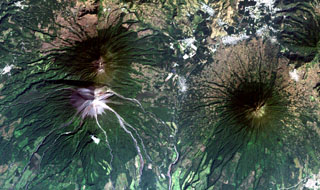 The historical city of Antigua Guatemala (top-right margin) is surrounded by three major stratovolcanoes in this Landsat view with north to the upper right. Dark-colored Acatenango volcano (upper left) and the unvegetated summit of Fuego volcano lie SW of the city, and Agua volcano (right-center) lies south. No historical eruptions from Agua are known, although mudflows in 1541 caused the abandonment of Ciudad Vieja, the previous capital city of Guatemala. Barrancas radiating SE from Fuego are light-colored from deposits of historical eruptions.
The historical city of Antigua Guatemala (top-right margin) is surrounded by three major stratovolcanoes in this Landsat view with north to the upper right. Dark-colored Acatenango volcano (upper left) and the unvegetated summit of Fuego volcano lie SW of the city, and Agua volcano (right-center) lies south. No historical eruptions from Agua are known, although mudflows in 1541 caused the abandonment of Ciudad Vieja, the previous capital city of Guatemala. Barrancas radiating SE from Fuego are light-colored from deposits of historical eruptions.  This February 2018 panorama shows the relative positions of several eastern Guatemalan volcanoes. From left to right are Fuego, Acatenango, Agua, and Pacaya.
This February 2018 panorama shows the relative positions of several eastern Guatemalan volcanoes. From left to right are Fuego, Acatenango, Agua, and Pacaya.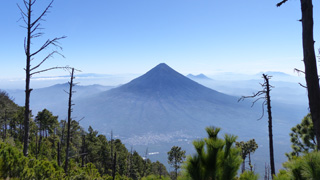 Volcán de Agua is seen here from the E flank of Volcán Acatenango. The peaks of Cerro Grande and Volcán Pacaya are visible behind Agua (right) and the town of Alotenango is below it.
Volcán de Agua is seen here from the E flank of Volcán Acatenango. The peaks of Cerro Grande and Volcán Pacaya are visible behind Agua (right) and the town of Alotenango is below it.There are no samples for Agua in the Smithsonian's NMNH Department of Mineral Sciences Rock and Ore collection.
| Copernicus Browser | The Copernicus Browser replaced the Sentinel Hub Playground browser in 2023, to provide access to Earth observation archives from the Copernicus Data Space Ecosystem, the main distribution platform for data from the EU Copernicus missions. |
| MIROVA | Middle InfraRed Observation of Volcanic Activity (MIROVA) is a near real time volcanic hot-spot detection system based on the analysis of MODIS (Moderate Resolution Imaging Spectroradiometer) data. In particular, MIROVA uses the Middle InfraRed Radiation (MIR), measured over target volcanoes, in order to detect, locate and measure the heat radiation sourced from volcanic activity. |
| MODVOLC Thermal Alerts | Using infrared satellite Moderate Resolution Imaging Spectroradiometer (MODIS) data, scientists at the Hawai'i Institute of Geophysics and Planetology, University of Hawai'i, developed an automated system called MODVOLC to map thermal hot-spots in near real time. For each MODIS image, the algorithm automatically scans each 1 km pixel within it to check for high-temperature hot-spots. When one is found the date, time, location, and intensity are recorded. MODIS looks at every square km of the Earth every 48 hours, once during the day and once during the night, and the presence of two MODIS sensors in space allows at least four hot-spot observations every two days. Each day updated global maps are compiled to display the locations of all hot spots detected in the previous 24 hours. There is a drop-down list with volcano names which allow users to 'zoom-in' and examine the distribution of hot-spots at a variety of spatial scales. |
|
WOVOdat
Single Volcano View Temporal Evolution of Unrest Side by Side Volcanoes |
WOVOdat is a database of volcanic unrest; instrumentally and visually recorded changes in seismicity, ground deformation, gas emission, and other parameters from their normal baselines. It is sponsored by the World Organization of Volcano Observatories (WOVO) and presently hosted at the Earth Observatory of Singapore.
GVMID Data on Volcano Monitoring Infrastructure The Global Volcano Monitoring Infrastructure Database GVMID, is aimed at documenting and improving capabilities of volcano monitoring from the ground and space. GVMID should provide a snapshot and baseline view of the techniques and instrumentation that are in place at various volcanoes, which can be use by volcano observatories as reference to setup new monitoring system or improving networks at a specific volcano. These data will allow identification of what monitoring gaps exist, which can be then targeted by remote sensing infrastructure and future instrument deployments. |
| Volcanic Hazard Maps | The IAVCEI Commission on Volcanic Hazards and Risk has a Volcanic Hazard Maps database designed to serve as a resource for hazard mappers (or other interested parties) to explore how common issues in hazard map development have been addressed at different volcanoes, in different countries, for different hazards, and for different intended audiences. In addition to the comprehensive, searchable Volcanic Hazard Maps Database, this website contains information about diversity of volcanic hazard maps, illustrated using examples from the database. This site is for educational purposes related to volcanic hazard maps. Hazard maps found on this website should not be used for emergency purposes. For the most recent, official hazard map for a particular volcano, please seek out the proper institutional authorities on the matter. |
| IRIS seismic stations/networks | Incorporated Research Institutions for Seismology (IRIS) Data Services map showing the location of seismic stations from all available networks (permanent or temporary) within a radius of 0.18° (about 20 km at mid-latitudes) from the given location of Agua. Users can customize a variety of filters and options in the left panel. Note that if there are no stations are known the map will default to show the entire world with a "No data matched request" error notice. |
| UNAVCO GPS/GNSS stations | Geodetic Data Services map from UNAVCO showing the location of GPS/GNSS stations from all available networks (permanent or temporary) within a radius of 20 km from the given location of Agua. Users can customize the data search based on station or network names, location, and time window. Requires Adobe Flash Player. |
| DECADE Data | The DECADE portal, still in the developmental stage, serves as an example of the proposed interoperability between The Smithsonian Institution's Global Volcanism Program, the Mapping Gas Emissions (MaGa) Database, and the EarthChem Geochemical Portal. The Deep Earth Carbon Degassing (DECADE) initiative seeks to use new and established technologies to determine accurate global fluxes of volcanic CO2 to the atmosphere, but installing CO2 monitoring networks on 20 of the world's 150 most actively degassing volcanoes. The group uses related laboratory-based studies (direct gas sampling and analysis, melt inclusions) to provide new data for direct degassing of deep earth carbon to the atmosphere. |
| Large Eruptions of Agua | Information about large Quaternary eruptions (VEI >= 4) is cataloged in the Large Magnitude Explosive Volcanic Eruptions (LaMEVE) database of the Volcano Global Risk Identification and Analysis Project (VOGRIPA). |
| EarthChem | EarthChem develops and maintains databases, software, and services that support the preservation, discovery, access and analysis of geochemical data, and facilitate their integration with the broad array of other available earth science parameters. EarthChem is operated by a joint team of disciplinary scientists, data scientists, data managers and information technology developers who are part of the NSF-funded data facility Integrated Earth Data Applications (IEDA). IEDA is a collaborative effort of EarthChem and the Marine Geoscience Data System (MGDS). |